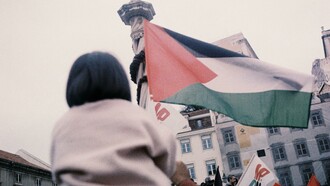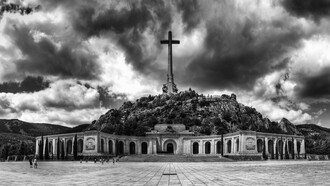After more than forty-five years of peaceful coexistence with the Warsaw Pact countries, NATO created a new image of itself with the collapse of the USSR as a war hawk bent on fighting for the global dominance of the USA.
When all think alike, then no one is thinking.1
Background
Since the end of the Cold War in the early 1990s, we have seen membership of the North Atlantic Treaty Organization (NATO) more than double. This is bizarre, when recalling that it was established as a bulwark against the spread of communism from the USSR to Western Europe. The USSR collapsed and ceased to exist in December 1991 as West Germany was reunited with East Germany.
In this article, we will explore the question of why an organization established to deter an enemy that no longer exists may continue to exist. These concerns have become particularly pronounced with the war in Ukraine, allegedly initiated by Russia, because, as President Putin states, the West crossed the red line by insisting that Ukraine must join the NATO alliance.
The war has resulted in the largest rearmament in Europe since the 1950s. NATO countries already have the most significant military budgets in the world, surpassing those of China and Russia. The winners of the rearmament are, first of all, the military-industrial complex. It was threatened with closures at the end of the Cold War, with no immediate replacement for the USSR as an enemy.
The American president, Bill Clinton, sought to expand NATO so that the arms industry could continue its lucrative business and maintain the USA as the world's largest arms exporter. Clinton "sold" the mission of NATO to Western European governments under the pretext of uniting Europe. Lobbyists from the arms industry likely planted the idea of integrating former Warsaw Pact countries into the liberal democracies of the West. The losers are the populations, particularly in Europe, who are being demanded to pay the costs for the defense against the forthcoming threat from enemy number one, Russia.
Some arguments underlie this paper
The presentations in this paper are based on the fact that the arms industries and their associated network of institutions, assembled under the umbrella of the military-industrial complex (MIC) in the early 1990s, were on the brink of closing down their business or, at best, reorganizing themselves in the absence of an enemy. NATO proved instrumental in creating the desired enemy. This occurred gradually over the next 25 years, with NATO's expansion through the addition of new members from the former Warsaw Pact countries.2
The narratives on Russia's invasion of Ukraine in February 2022 stress that President Putin dreams about restoring Russian dominance and control of countries within borders similar to those of the former Soviet empire. The Western media regularly informs its audiences that President Putin cannot be trusted and that he will soon bring the War to their doorsteps. Western leaders have cut themselves off from a negotiated solution to the Ukrainian conflict by making humiliating statements about Putin and Russia. These narratives, while withholding key information, serve to justify rearmament.
The world is told that the mission of NATO is to secure peace, promote democracy and freedom not only for populations of its member countries but for the world as a whole. However, since the end of the Cold War in 1991, NATO has become increasingly aggressive. It has launched wars, which conflict with its foundation in the UN Charter and often contradict resolutions by the Security Council.
During the negotiations on German reunification, US Secretary of State James Baker promised not to expand NATO one inch to the east. Nevertheless, hardly had the Cold War ended and the Warsaw Pact countries dissolved before it did precisely that. The leadership of NATO and its masters in Washington have been creative in admitting new countries to NATO as members or partners, as long as they accept procedures for arms procurement coordinated by NATO's Support and Procurement Agency.
The people in the political West are daily told that they cannot trust either the Russian or Chinese leaders. The public is informed that these two countries have developed sophisticated cyber strategies to influence the political processes of Western democracies and shape the attitudes and behaviours of Western populations. In fact, NATO is working hard to influence global opinion. It has already made good progress with respect to the creation of a supportive home audience for its increasingly hostile and aggressive behaviour towards enemies designated as such by the USA.
Review of NATO on NATO
The US government established NATO at the end of World War II. NATO justifies its existence with reference to Article 51 in the UN Charter.3 The NATO website informs its readers that the founding member countries “...are determined to safeguard the freedom, common heritage, and civilization of their peoples, founded on the principles of democracy, individual liberty, and the rule of law. They seek to promote stability and well-being in the North Atlantic area."4 Its primary mission is to protect the North Atlantic countries against the spread of communism emanating from the USSR and from national communist parties within member countries.
The US viewed communists as a threat to the security of Western Europe because they took orders and guidance from the mother party in Moscow. Hence, NATO/USA established clandestine organizations in most member countries.5 In collaboration with national intelligence agencies, including the CIA, they undertook terrorist activities, including torture, assassinations, psychological warfare, and any activity that could contribute to delegitimizing communist and left-wing organizations. The USA strongly supported these secret paramilitary groups during the period of McCarthyism6 in the 1950s. This aspect of NATO highlights an often-overlooked objective of NATO, notably that of ensuring American control over Europe.
The collapse of the USSR and the abolition of the Warsaw Pact
NATO's founding members comprised 12 nations. At the end of the Cold War in 1991, it had 16 member countries. In 2024, it consisted of a total of 32 member countries and 35 partner countries. The Soviet Union established the Warsaw Pact in 1955 in response to a perceived threat from West Germany, following its admission to NATO. The Warsaw Pact countries dissolved in July 1991, marking the effective end of the Cold War. There was thus high faith in the possibility of disarmament and that the ensuing peace dividend would benefit increased social welfare for the populations.
However, hardly had the communist threat perished before NATO opened up for engagements with former Warsaw Pact members by inviting them to participate in the North Atlantic Cooperation Council.7 It was a forum for discussions between NATO countries and former Warsaw Pact countries, and in fact, a thinly disguised invitation to join NATO.
NATO expansion: an obstacle to Russian democracy
Shortly before the collapse of the Soviet Union, NATO invited a high-level Soviet military committee to Brussels. This committee reported back to Yeltsin that it had informed the NATO administration that conservative forces in the USSR would be ready to exploit NATO's expansionary policies to preserve the USSR's military-industrial complex in its current state, thereby seriously slowing down democratic transformations.8
The USSR was not alone in its opposition to NATO's expansion. George Kennan, one of the founders of the US policy of containment of the USSR, had developed an attitude of rapprochement between the West and the USSR/Russia during the Cold War period. Kennan had become an advocate for peaceful coexistence with Russia and the former Soviet republics. He stated that "…expanding NATO would be the most fateful error of American policy in the entire post-Cold War era. Such a decision may be expected to inflame the nationalistic, anti-Western, and militaristic tendencies in Russian opinion, …"9
In an interview, Kennan is quoted to have said that “Our differences in the Cold War were with the Soviet Communist regime. And now we are turning our backs on the very people who mounted the greatest bloodless revolution in history to remove that Soviet regime (…... ) and leading to unprecedented arms control agreements with the US (….. ) And what was America's response? It was to expand the NATO Cold War alliance against Russia and bring it closer to Russia's borders."10
The concerns regarding NATO expansion also rest at the centre of attention of the Arms Control Association (ACA), founded in 1971. ACA addressed an appeal to President Clinton on June 26, 1997. Fifty military and diplomatic experts co-signed it. They expressed their opposition to the expansion of NATO, arguing that it was needlessly provocative to Russia. The argument presented to President Clinton was that Russia did not pose a threat to its western neighbours. The ACA argued that NATO expansion would make it much more challenging to establish an atmosphere of trust required for Moscow and the West to continue talks on arms reduction that began in 1990.
Russia reaches out to the West
Russia today holds a similar position on the enlargement of NATO towards its borders as did Presidents Gorbachev and Yeltsin almost 30 years ago. During the talks on German reunification, Gorbachev requested that the Soviet Union join the Western European countries in a pan-European organization. The proposal was turned down by the USA, perhaps because it was convinced that Russia would never, in the long term, accept the dominance of the USA and its inherent wish to control Europe. Another hypothesis is that the US, already at that time, was playing games with the USSR negotiating team, just pretending that there were no plans to expand NATO.
President Putin has always been clear on the subject of NATO moving closer to Russia's borders. In 2001, he declared in a speech to the German parliament that Russia was ready for a genuine partnership with Europe and NATO. His appeasing speech was not accepted, and the containment of Russia continued with Poland, the Czech Republic, and Hungary becoming full NATO members in 1999. Putin's tone became more pointed after the NATO decision at the Bucharest summit in 2008 to eventually admit Ukraine and Georgia as members.
In his intervention at that summit, Putin made it clear that Ukraine would be the red line. Several key European countries were also opposed to Ukraine and Georgia's admission to the Alliance. Some months before the Russian invasion in February 2022, Russia proposed an accord with NATO, indicating that it would abstain from invading Ukraine if NATO agreed to a neutral Ukraine. 11 As we know now, the Western nations did not agree to the signing of such a document. Putin's proposal was merely a way of formalizing promises made by Western leaders during the negotiations in 1989/90. 12
NATO justifies its policy of expansion
NATO justifies its continued expansion by stating that “NATO’s enlargement has been a historic success. It has strengthened our Alliance, ensured the security of millions of European citizens, and contributed to peace and stability in the Euro-Atlantic area. NATO declared that “We are a defensive Alliance. The Russian Federation has violated the norms and principles that contributed to a stable and predictable European security order. We cannot discount the possibility of an attack against the Allies' sovereignty and territorial integrity.
The threats we face are global and interconnected."13 These are bold statements meant to deceive and undermine decision-making by lawmakers in European countries, especially when well-sourced information has revealed that the expansion of NATO began as an undertaking to save the American arms industry14, thus safeguarding the USA as the world's largest arms exporter.
From defence and deterrence to warmongering
Remarkably, it took 46 years after NATO's inception in 1949 for the Alliance to undertake its first-ever military intervention, which ultimately led to the breakup of the Federal Republic of Yugoslavia. NATO's involvement in Yugoslavia served first of all to show the European member states that they need NATO and the continued stay of US troops in Europe. It also taught Europeans and the rest of the world that the US would intervene in sovereign countries, regardless of UN resolutions.
The Americans determined the strategy for NATO's interventions in the Federal Republic of Yugoslavia, resulting in heavy bombardment in 1999, leading to the collapse of Yugoslavia. The disintegration of Yugoslavia also meant the end of the welfare state that had been secured under Tito's brand of socialism. NATO clearly demonstrated its readiness to promote the Western brand of democracy, with an emphasis on a market economy. When Poland applied for membership to NATO, the PM was informed by the American administration that it would have to privatize large state enterprises before joining.
When the counterforce of the USSR disappeared in 1991, the Americans felt almighty. The US government frequently took advantage of NATO. Since its first involvement in active warfare in Yugoslavia, NATO has been a key participant in 24 interventions from Yugoslavia to Libya, Somalia, Afghanistan, and Iraq. The US was the first NATO country to make use of Article 515 to summon the participation of other member countries to fight international terrorism following the attacks in the US on September 11, 2001. NATO's intervention in Libya put an effective halt to decolonization in most of West and Central Africa.16 India’s first prime minister had already, in 1955, classified NATO as the biggest obstacle to decolonisation.17
EU and NATO collaboration
A handful of arms manufacturers based in the US and Europe provide most of the armoury to NATO member nations and partners. NATO's purchases position the Alliance as one of the countries with the largest military budgets in the world, accounting for approximately 70% of global military expenditures. In comparison, China accounts for 19%, and Russia for 6%. Iran accounts for only 0.4% of global military spending. Despite this tiny contribution, the media has made Iran appear as a threat to world peace.
At the 2024 Washington Summit, the NATO Alliance agreed to the NATO Industrial Capacity Expansion Pledge. It aims to strengthen transatlantic cooperation with the arms industry, helping European allies in particular to restock their arsenals, while continuing to send military aid to Ukraine. Through its Support and Procurement Agency, NATO helps Allies with the procurement of new weapon systems, vehicles, and other major equipment.
One of the conditions for gaining the status of a NATO partner is to accept and practice the concept of 'interoperability,' which means that a partner country must procure weapons produced in the USA and Europe, approved by the NATO Procurement Agency,18 which currently manages 32 partnerships covering over 90 major weapons systems (helicopters, radars, missiles, armoured vehicles, airborne surveillance systems, etc.). The war in Ukraine has accelerated all activities related to the production, distribution, and sale of weapons. The EU gave a boost to these rearmament efforts by launching in 2023 the Collaborative Procurement of Ammunition project. The objective was to facilitate military support from partner countries to NATO operations.
Securing European unity for NATO's proxy war in Ukraine
The media rarely report on Putin's declared motives for invading Ukraine. Neither does mainstream media inform about his proposal to NATO before the invasion. Nor do the media make any mention of Putin's peace proposal prepared with Ukraine a few months after Russia's invasion in 2022. The agreement was never signed because the American messenger to Ukrainian President Zelensky, in the person of the UK Prime Minister Boris Johnson, instructed the Ukrainians not to sign. The continued war in Ukraine serves not only to bolster the arms industry but also to avoid Europe becoming dependent on Russia in any way. Such dependency would pose a direct threat to US domination.
This was brought to the foreground when the Nord Stream gas pipeline was blown up in the Baltic Sea on 26. September 2022, just off the coast of Denmark and Sweden. The pipeline had been constructed at a cost of more than $22 billion. Europeans had long looked forward to benefiting from affordable energy from Russia. The major problem for the Americans and Ukraine is that the supply of energy from Russia would render uncertain Europe's position as a loyal supporter of the US/NATO-led Ukraine war against Russia.
NATO and Western countries have refused to accept Russia's participation in the investigation of the sabotage act for which nobody has claimed responsibility. The disclosure of the executioner of this act of terrorist sabotage, regardless of whether it points towards Ukraine or even towards the US, would have geopolitical consequences. Given the fact that the Baltic Sea is the most surveyed strait of water in the world.19,20 Observers believe that the US knows who committed the act. Strong indications suggest that Ukraine and Poland were involved in the physical execution, with advice and training provided by the USA.
The expansion of NATO to former Warsaw Pact countries receives loyal support from the EU. In 2009, one year after NATO declared Ukraine a potential member, the EU launched its Eastern Partnership Initiative to promote integration into the EU economy. Russia views the Initiative as another threat to its interests. In fact, Moscow considers the EU as an instrument of NATO for its enlargement.
The social engineering that took place in Ukraine by players such as Soros' Open Society and the National Endowment for Democracy made Russia believe that it could be the next target. "NATO enlargement, EU expansion, and democracy promotion are a close-knit package of policies designed to integrate Ukraine into the West without antagonizing Russia. However, they inadvertently turned Moscow into an enemy, leading directly to the Ukraine crisis."21 The arms industry has gotten its enemy, as it demanded at the end of the Cold War.
Concluding words
How is it possible that the populations of countries that claim to uphold the principle of freedom of expression, nearly three years after the largest terrorist attack on a European infrastructure, are still unaware of the identity of the perpetrators? In the second part of this article, we will attempt to identify the influence of the arms industry on Western public opinion, and more specifically on that of NATO member countries.
Notes
1 Quote attributed to Walter Lipmann, 1934.
2 On May 14, 1955, the USSR and seven other Eastern European countries established the Warsaw Pact in response to the integration of the Federal Republic of Germany into NATO.
3 Article 51 stresses: Nothing in the present Charter shall impair the inherent right of individual or collective self-defence if an armed attack occurs against a Member of the United Nations, until the Security Council has taken measures necessary to maintain international peace and security.
4 Signed by the founding parties on April 4, 1949.
5 Usually known under the name of Gladio. In Denmark, this secret group was known as Absalon.
6 Senator Joseph McCarthy spearheaded a witch-hunt against anyone suspected of harbouring sympathy towards left-wing ideologies, especially individuals in the public administration, who were believed to have links to the communist party. His agitation gave name to these activities under the banner of McCarthyism, which was strongly felt during the 19.
7 Established by the Allies in December 1991 as a forum for dialogue and cooperation with NATO's former Warsaw Pact adversaries.
8 President of the USSR Yeltsin Boris Nikolayevich; Memorandum about the results of the delegation of the Supreme Soviet of the RSFSR's visit to Belgium on the invitation of the NATO Headquarters.
9 A fateful error, by George F. Kennan. New York Times 5.2.1997.
10 George Kennan, in an interview with Thomas L. Friedman. New York Times, May 2, 1998.
11 Revelation by former Secretary General of NATO, Stoltenberg, on September 7, 2023, in a discussion with EU parliamentarians. Source: I’OTAN, Une Alliance au Service de la Guerre, by Medea Benjamin and David Swanson, Lux 2022.
12 NATO Expansion: What Gorbachev Heard, National Security Archive. George Washington University. Washington D.C., December 12, 2017 (The archives were kept at the National Security Archive. George Washington University, 2017).
13 Quoted from NATO 2022 Strategy Concept.
14 The spoils of War. Power, Profit and the American War Machine, by Andrew Cockburn. Verso 2023.
15 Article 5 states that "The Parties agree that an armed attack against one or more of them in Europe or North America shall be considered an attack against them all."
16 How NATO crushed Africa’s path to freedom, by Kristian Laubjerg. Meer Magazine July 20, 2025.
17 India's prime minister Jawaharlal Nehru at the Bandung Conference of non-aligned countries.
18 NATO Support and Procurement Agency, located in Luxembourg, employs more staff than NATO HQ in Brussels.
19 Trois scenarios pour un attentat, by Fabian Scheidler, in Le monde Diplomatique, October 2024.
20 The Nord Stream Explosions: New Revelations about motive, means, and opportunity, by James Bamford. World, May 5, 2023.
21 The Great Delusion. Liberal Dreams and International Realities, by John J. Mearsheimer, Yale University Press, 2018.















